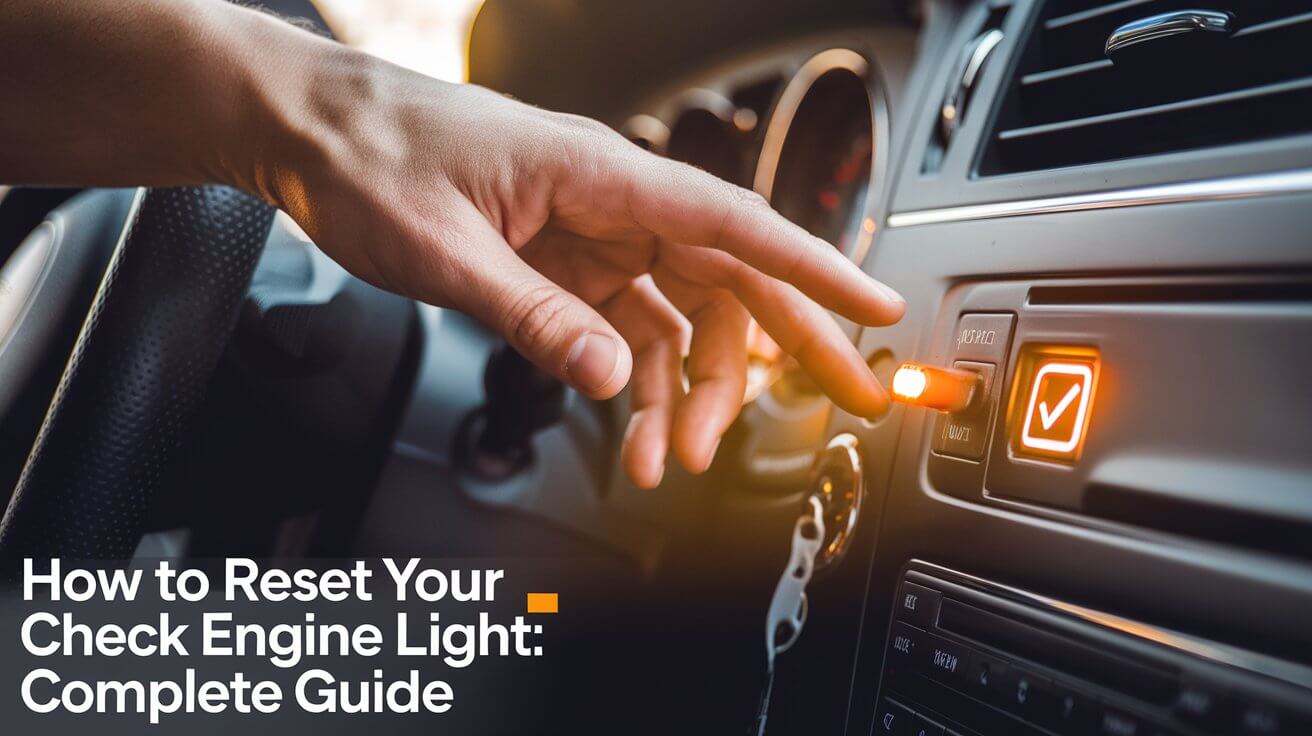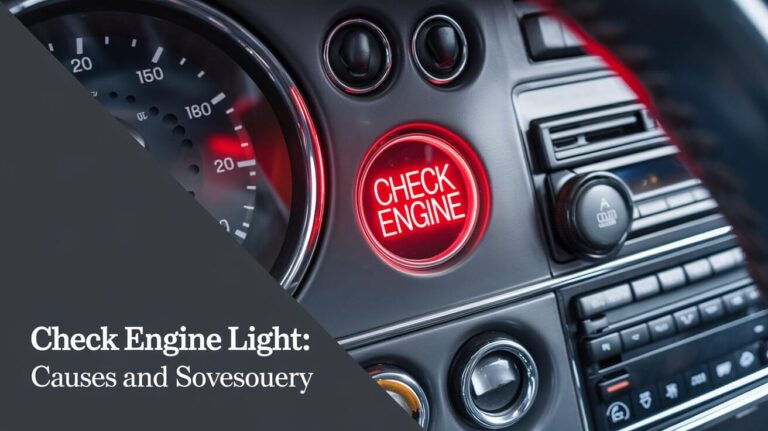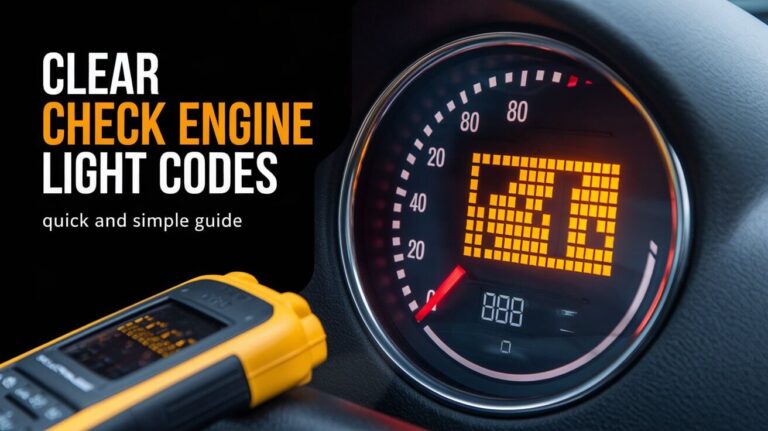How to Reset Your Check Engine Light (Complete Guide)

If your check engine light suddenly pops on, it can cause immediate concern. But before you panic, it’s essential to understand that this warning light may not always signify a severe issue. Sometimes, the check engine light comes on due to minor problems, and resetting it might resolve the issue. In this guide, we’ll dive deep into how to reset your check engine light and explore various ways to clear it with or without an OBD-II scanner.
Common Reasons Why the Check Engine Light Turns On
Before resetting the check engine light, it’s crucial to understand why it turned on in the first place. The check engine light is part of your car’s onboard diagnostic system (OBD-II), which monitors various components and systems in the vehicle. Here are some of the most common reasons it illuminates:
Loose or Faulty Gas Cap
One of the most straightforward causes of a check engine light is a loose or cracked gas cap. The fuel system maintains pressure, and a loose gas cap can trigger the light.
Faulty Oxygen Sensor
The oxygen sensor measures the amount of unburned oxygen in the exhaust system. A faulty sensor can cause issues with the engine’s fuel-to-air ratio, leading to higher fuel consumption and emissions.
Failing Spark Plugs
Old or worn spark plugs can cause the engine to misfire, which will trigger the check engine light. Replacing spark plugs regularly is key to maintaining optimal engine performance.
Engine Misfire
Misfires occur when the engine’s cylinders don’t fire correctly, causing rough running and the check engine light to come on.
Catalytic Converter Issues
The catalytic converter is crucial for reducing harmful emissions. If it’s damaged or clogged, the check engine light will turn on.
Other Emission Control System Failures
Issues with the emission control system, including the mass airflow (MAF) sensor and evaporative emission control system (EVAP), can also cause the check engine light to illuminate.
Method 1 – Resetting Check Engine Light Without Tools
Turning the Car On and Off (Method 1)
A simple and safe method to reset the check engine light without tools is by turning your car on and off three times. Here’s how:
- Insert your key and turn the ignition to the ON position without starting the engine.
- Wait a few seconds.
- Turn the key back to the OFF position.
- Repeat this process two more times, then start the engine.
This process forces the car’s onboard computer to reset itself and check if the underlying issue is resolved. If the problem is minor, such as a loose gas cap, this method can effectively reset the light.
Disconnecting and Reconnecting the Battery (Method 2)
Another widely used method to reset the check engine light is disconnecting and reconnecting the battery. This technique effectively erases the error codes stored in the electronic control unit (ECU). Follow these steps:
- Turn off the engine and ensure the car is in park.
- Use a wrench to disconnect the negative terminal of your car’s battery.
- Leave it disconnected for about 10-15 minutes to ensure the ECU resets.
- Reconnect the negative terminal and tighten the clamp.
- Start the engine.
This process will reset the ECU, but be aware that it also resets other electronics, such as your radio presets. If the issue persists, the light will come back on, and further diagnostics may be needed.
Method 2 – Using an OBD-II Scanner (The Best Option)
What is an OBD-II Scanner and How Does It Work?
An OBD-II scanner is a diagnostic tool that connects to your car’s onboard computer system. It allows you to read error codes, identify the exact problem, and reset the check engine light once the issue is resolved.
OBD-II scanners are widely available and easy to use. Many auto parts stores also offer free diagnostic services using these scanners, so you don’t need to purchase one yourself if you prefer not to.
Step-by-Step Guide to Reset the Check Engine Light Using an OBD-II Scanner
Here’s a detailed guide on how to use an OBD-II scanner to reset your check engine light:
- Locate the OBD-II Port: The OBD-II port is typically located under the dashboard on the driver’s side.
- Connect the Scanner: Plug the OBD-II scanner into the port.
- Turn on the Ignition: Turn the ignition to the ON position without starting the engine.
- Read the Error Codes: Follow the scanner’s instructions to read the error codes. These codes will help you understand the issue.
- Clear the Codes: Once you’ve resolved the issue, use the scanner to clear the codes and reset the check engine light.
This method is highly reliable because it not only resets the light but also gives you an accurate diagnosis of the underlying problem.
Method 3 – Allowing the Check Engine Light to Turn Off Automatically
Natural Extinction of the Check Engine Light
In some cases, the check engine light will turn off automatically after driving the car for a few cycles. This typically happens when the issue was minor, such as a loose gas cap, and has been resolved. Here’s how it works:
- After fixing the issue, drive the car normally for 30-50 miles over several driving sessions.
- The car’s onboard computer will perform system checks during this time.
- If the issue no longer exists, the check engine light should turn off on its own.
This method is less reliable than using an OBD-II scanner, but it can work if the problem was temporary or minor.
Should You Reset the Check Engine Light Without Fixing the Problem?
While resetting the check engine light may seem like a quick fix, it’s important to diagnose and resolve the underlying issue before clearing the light. Ignoring the root cause can lead to more severe problems, including costly repairs down the road.
In some cases, a check engine light may indicate a serious issue, such as a failing catalytic converter or engine misfire. Resetting the light without addressing the problem can result in engine damage, reduced fuel efficiency, and even increased emissions.
Diagnosing the Problem Behind the Check Engine Light
Reading Error Codes and Fixing the Issue
To accurately diagnose the issue behind the check engine light, you’ll need to read the error codes stored in the car’s onboard computer. These codes can be read using an OBD-II scanner or by visiting an auto parts store that offers free diagnostic services.
Here are some common error codes and their meanings:
- P0128: Coolant thermostat temperature below regulating temperature.
- P0300: Random/multiple cylinder misfire detected.
- P0420: Catalyst system efficiency below threshold.
- P0456: Evaporative emission system leak detected (very small leak).
Once you’ve identified the problem, you can take steps to fix it, whether it’s replacing a faulty sensor, tightening a gas cap, or addressing a more serious issue like a failing catalytic converter.
Free Check Engine Light Diagnosis Services
Many auto parts stores, such as AutoZone, offer free check engine light diagnostic services. They will use an OBD-II scanner to read the error codes and help you understand what repairs may be needed. This can save you time and money by providing a free, accurate diagnosis.
How Long Does It Take for the Check Engine Light to Reset?
The time it takes for the check engine light to reset depends on the method you use:
- Using an OBD-II Scanner: The light should turn off immediately after clearing the codes with a scanner.
- Disconnecting the Battery: The light should turn off once you reconnect the battery and start the car.
- Driving the Car (Automatic Reset): It can take several driving cycles (30-50 miles) for the light to turn off if the issue has been resolved.
If the light remains on after trying these methods, the issue likely hasn’t been fixed, and further diagnostics are necessary.
Can Resetting the Check Engine Light Fail?
In some cases, resetting the check engine light may not work as expected. Here are a few reasons why:
- The Problem Isn’t Resolved: If the underlying issue hasn’t been fixed, the light will likely come back on after resetting it.
- Faulty Sensors: A faulty sensor, such as a malfunctioning oxygen sensor, may continuously trigger the check engine light even after it’s reset.
- Wiring Issues: Electrical problems, such as damaged wiring or connectors, can cause the light to stay on.
If resetting the light fails, it’s essential to perform a more thorough diagnosis using an OBD-II scanner or consult a mechanic.
Frequently Asked Questions
Can You Drive with the Check Engine Light On?
In most cases, you can still drive with the check engine light on, especially if the light is steady and not flashing. However, if the light is flashing, it indicates a more severe issue, such as an engine misfire, and you should stop driving immediately and seek professional help.
What’s the Difference Between a Flashing and Solid Check Engine Light?
A flashing check engine light typically indicates a more severe problem, such as a misfire, that requires immediate attention. A solid check engine light suggests a less urgent issue, but it still needs to be addressed.
Will Resetting the Check Engine Light Cause Any Harm to the Car’s System?
Resetting the check engine light itself won’t harm your car’s system, but ignoring the underlying problem could lead to more significant issues over time.
Can the Check Engine Light Come Back After Resetting It?
Yes, if the issue causing the check engine light hasn’t been resolved, the light will come back on after resetting it.
Conclusion
The check engine light serves as an essential warning system for your vehicle, alerting you to potential…issues within your car. While resetting the light can be helpful for clearing up false alarms, it’s crucial to identify and fix the underlying issue to prevent any long-term damage. Whether you opt for the simple ignition cycling, battery disconnect method, or using an OBD-II scanner, each method has its pros and cons.
Taking care of small problems promptly, like tightening the gas cap or replacing a sensor, can save you from more expensive repairs down the line. Remember, while resetting the check engine light is useful, it should never be a substitute for proper vehicle maintenance and diagnosis.
Following these steps and methods will ensure that you reset your check engine light the right way and address the cause of the warning light. It’s always a good idea to periodically check your vehicle’s systems and use preventative measures to avoid seeing that light pop up in the future. Safe driving!


